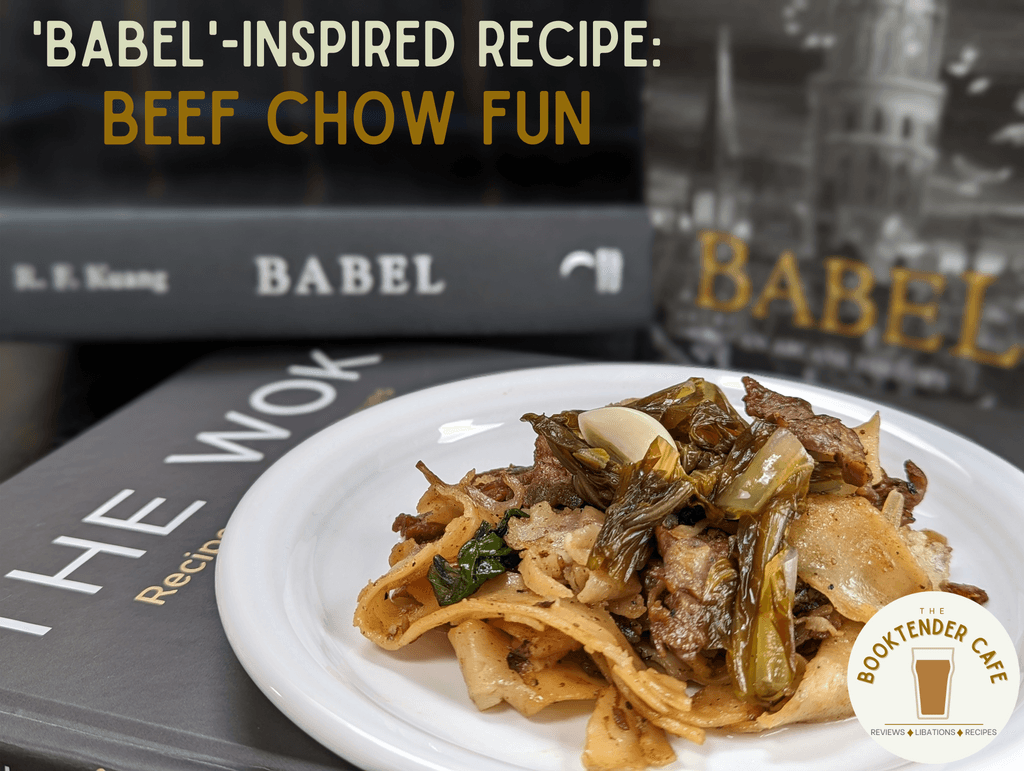Inspired by Babel by R.F. Kuang
This recipe was inspired by ‘Babel’ by R.F. Kuang, a dark academia historical fantasy book with roots in Oxford and Canton. I also created Sweet & Sour Pickled Mustard Cabbage and New College Pudding. Please enjoy the recipes and book review!

This recipe is from J. Kenji Lopez Alt’s Youtube channel. The same recipe, with slight alterations, can be found in his ‘The Wok’ cookbook, which I own and absolutely adore. It has not only an insane amount of delicious recipes but also very useful tips and explanations of techniques.
In Babel, one of the main protagonists is Robin Swift, who was born in Canton, China. Throughout the book, there are several mentions and flashbacks to Canton and I wanted to cook something that has Cantonese roots in it as an homage to Robin. Kenji’s beef chow fun is a fantastic dish, and while it is more hands-on than I initially anticipated, it is extremely worth the effort.

There is a legend surrounding the origins of beef chow fun, which can not exactly be verified. It goes that during World War II in Canton (now Guangzhou), a food stall owner named Mr. Hui ran out of potato starch powder one evening, which he needed for his wet-style chow fun. Due to the curfews in place, Mr. Hui was unable to leave and go purchase more for his food stall.
A military commander walked up and wanted to order the typical wet chow fun, and was upset to learn he was not going to be able to have any. Since Mr. Hui didn’t have any powder to make his chow fun sauce, he had to get creative or face potential violence. While Hui’s mom and brother worked on making tong huen (sticky sweet rice dumplings) to please the commander, Hui innovated and created the dry-style chow fun (no thick sauce), which is the style I made to honor Robin Swift in Babel.


If you do not have access to an outdoor burner to cook this on, you can make it inside with a blowtorch to add that extra smokiness, the wok hei as Kenji states. If you don’t have a blowtorch, you could put everything on a baking sheet after cooking and pop under the broiler briefly until you get some nice charring on some of the pieces, but keep a close eye or else it could get a bit too charred.
Alongside the chow fun, I also made Sweet & Sour Pickled Chinese Mustard Cabbage. The recipe is from ‘Asian Pickles At Home’, by Patricia Tanumihardja, which I have slightly adapted. And to finish out the Babel-inspired menu, I made New College Pudding for dessert. Click the link to learn why it is named that!
You can read my review of Babel here, and you can purchase the book through Bookshop.org (affiliate link to help support The Booktender Cafe, at no extra cost to you).
If you try this recipe out, I’d love to see what you make! Please tag me on Instagram @thebooktendercafe
Beef Chow Fun

Beef chow fun is a popular Cantonese dish that features marinated beef strips stir-fried with fragrant scallions and vegetables, combined with wide rice noodles. The below recipe is adapted from J. Kenji Lopez-Alt, you can view his Youtube video below or view the recipe is his cookbook, The Wok.
This dish is part of my Babel (by R.F. Kuang) inspired menu and is great with the Sweet and Sour Pickled Chinese Mustard Greens recipe I made, adapted from Patricia Tanumidharja's 'Asian Pickles At Home' cookbook! Also part of that menu, is my adaptation of the New College Pudding with Brandy Sauce.
Ingredients
- For the Beef: (needs 15 minutes up to overnight to marinate)
- 8 ounces (227 grams) flank steak, skirt steak, - thinly sliced against the grain
- 1/4 tsp baking soda
- 1 tsp light soy sauce
- 1 tsp dark soy sauce
- 1 tsp Shaoxing wine
- 1/2 tsp corn starch
- For the Stir-Fry:
- 8-10 ounces (227-284 grams) fresh hor fun noodles, wide rice noodles (I found in the refrigerated area of my local Asian market)
- Neutral oil (such as peanut or vegetable
- 1/4 small yellow onion, sliced
- 3 cloves garlics, minced
- 3 green onions, cut into 2-inch segments
- 1 cup (approximately 90 grams) mung bean sprouts, rinsed thoroughly
- 1 Tbsp light soy sauce (this is not "lite" as in low-fat etc.), divided
- 1 Tbsp dark soy sauce (or regular/light soy sauce), divided
- 1 Tbsp Shaoxing wine, divided
- Pinch MSG, optional
- Pinch ground white pepper
- For serving:
- Pickled Chinese mustard greens
Instructions
1. Ensure you have all ingredients set up on the counter, pre-measured, pre-cut, and ready to go. This will go very quickly and you will not have time to cut veggies or get out the bottle of Shaoxing wine in time, once the cooking begins. Best to be prepared!
2. Combine the beef, soy sauces, baking soda, wine, and corn starch in a small bowl and mix together aggressively. Place in the refrigerator for a minimum of 15 minutes, or overnight ideally.
3. Bring a pot of water with a good pinch of salt added, to a boil. Add noodles and cook, stirring gently as to not break them. If using fresh noodles, cook until they are tender, roughly 1 minute. If you are using dry noodles, you will cook a few minutes longer. My refrigerated hor fun noodles took 6 minutes. They will be cooked more in the wok, so don't overcooked them now. Drain the noodles, rinse under cool water, let them drain once more, then add a couple teaspoons of neutral oil to ensure they do not stick together. Move them to a rimmed baking sheet.
4. Place a colander over a heat-proof bowl, and place them in your sink. You will be reserving the oil you cook the beef in, and using it later.
5. Heat one cup of neutral oil in the wok over high heat until the oil is shimmering. Add in the beef and cook, stirring pretty constantly, until the beef is just barely cooked through, roughly 30 seconds. Drain the beef into the colander with the bowl under it, reserving the oil in the bowl and setting the drained beef aside. Wipe out the wok with a paper towel.
5. Heat the wok back up on high heat. Add a tablespoon of the reserved oil, and swirl it around the wok to coat. Add the drained noodles and stir-fry over max heat. If you are doing this inside your kitchen and own a blowtorch, hit the noodles with the torch until they are lightly charred in spots, roughly 1 minute. If you do not own a blowtorch, see my note down below. If you are cooking this outside like Kenji does in his food, follow his lead and I admire your set up. Mix 2 teaspoons each of the light and dark soy and 2 teaspoons of the Shaoxing wine together, then add it by swirling it around the walls of the wok and toss to combine, stir fry until the noodles soaked up the sauce. Transfer back to the rimmed baking sheet.
6. Return the wok back to high heat. Add one tablespoon of oil and swirl to coat the wok. Add your prepped onions, garlic, green onions, and mung bean sprouts, toss to combine, and stir-fry until tender but crisp, roughly 20 seconds. Add in the cooked noodles and beef to the wok with the veggies. Season with MSG (if using, it does add great flavor), white pepper, and remaining amounts of Shaoxing wine and both soy sauces. Toss to combine, being careful not to break the noodles. Take off heat.
7. Now there are a few options you can choose:
a. You have the outdoor set up like Kenji, you just need to transfer everything to plates and eat up!
b. You are cooking inside, with access to a blowtorch. Fire up the blowtorch and hit the noodles, beef, and veggies with it and get some char on everything. Don't overdo, the charred bits carry a lot of flavor, even in small quantities. Serve and enjoy.
c. You are cooking inside, without access to a blowtorch. Put everything on a rimmed baking sheet and put under your oven broiler. Keep a close eye on this as it will burn very quickly! Stir everything to get a nice, even charring, if possible.
8. Serve with pickled Chinese mustard greens.
